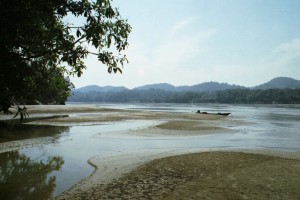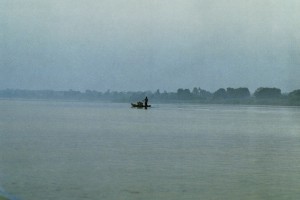[In January 2003 I accompanied an expedition that was conducting a survey of river dolphins on a stretch of the Mekong River in Cambodia. The expedition was led by Isabel Beasley, who was then a PhD student specializing on Orcaella brevirostris: also known as the ‘Irrawaddy Dolphin’ this species is found in many Asian river systems and deltas.
Over the last few weeks I’ve posted the first part of the journal I kept during the expedition: this is the 30th and final post in the present series. I plan to post other parts of the journal later in the year.]
The survey that Isabel is doing is a ‘direct count’ survey – which means that she is trying to physically count every member of the orcaella population. This is different in principle from a ‘line-transit’ survey where essentially the data from a certain area is used to extrapolate figures and statistics for a wider population. That is why in a ‘line-transit’ survey great care has to be taken that lines of sight etc don’t overlap – because if they do, then the extrapolation would produce figures that are radically skewed.
The river’s course was much broken and fragmented for much of the way today – in places there were huge islands and the channels narrowed as the river parted. In other places the current was so fast that the water was white in patches.
There were acres of bush- and rock-strewn water. Then about fifteen miles south of Stung Treng, the river changed again and there was only one broad channel and the shores were densely inhabited. Huts lined the bank almost without a break. It was like this all the way to Stung Treng and there the river divided again. It’s been pleasantly cool since we left Kratie; last night was cold and the mornings on the river are chilly too.
Every now and again Isabel makes a stop to talk to the local fishermen; she asks them about the dolphins and the giant catfish (which was seen up here until quite recently) and she takes pictures of their nets. The kind of net she is concerned about is the ‘gill net’. These are nylon nets that have a large mesh, in which dolphins very easily get entangled. The smaller mesh nets don’t really trouble them as they don’t get entangled in them, but the large mesh nets can snag on many parts of their bodies and they can drown in a matter of minutes.
Isabel and the others are just back from the survey and they had a good day: they met a ‘travelling group’ of dolphins (between 7 and 13) and followed them for quite a while. The dolphins got alarmed at a certain point and began to push the upper part of their bodies out of the water, swimming in the fashion of ocean dolphins.
Isabel is working on a paper on the taxonomy of orcaella. She is hoping to show that the Australian orcaella and the Asian orcaella are different species. In order to write this paper she had to travel around the world: she had to visit every museum that has an orcaella skull. Her travels took her to Calcutta, Paris, London, Copenhagen and many cities in the US. Paris had a particularly rich trove of skulls. ‘Didn’t see anything of the cities – just went straight from museum to museum.’ In the process she met many of the curators who have become legendary in the field and most of them were ‘terribly nice’.
It struck me that this was in a way similar to working with Geniza documents – chasing a trail of paper around the world. But there are other similarities as well – learning to recognize minute differences; patience; engaging with work that has preceded one’s own – and so on.





This is beautiful. I love your travel writing, Mr Ghosh.